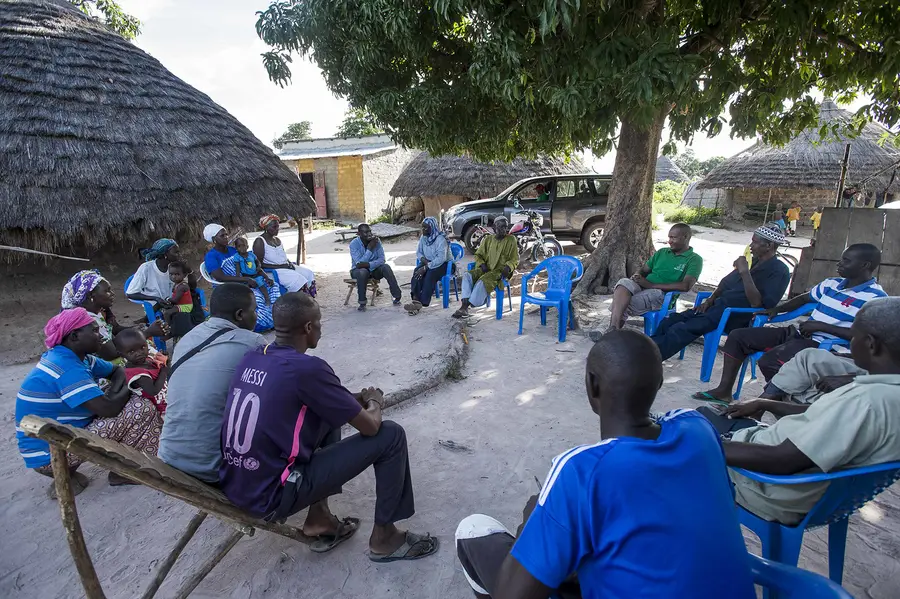Insights
Integrated Governance Then and Now: Beyond Hammers and Nails

This is the first in a series of three Insights posts about integrated governance. Read the second blog here.
The social psychologist Abraham Maslow observed that when all you have is a hammer every problem looks like a nail. This is often interpreted as overreliance on a familiar tool and succinctly characterizes much international development policy and practice, which divides its operational territory into sectors. Sector specialists, by virtue of their training and experience, prioritize the kinds of problems (nails) that can be solved using their sector’s tools and approaches (hammers). Problems that are not readily amenable to solutions with the sector’s familiar toolkits receive less attention.
However, individual wellbeing, community development, and societal advancement do not fall neatly into sectoral categories: a single-hammer toolkit is destined to be insufficient. The past decades have seen various efforts to increase the prospects for effective and sustainable international development, many of which share a common focus on best practices for integration, both across sectors and within local contexts.
Donors and practitioners increasingly recognize that the success of sector reforms is influenced by, and often dependent on, the quality of governance. Donor reform designs vary in response to this recognition: from (1) trying to wall off sector programs from the local governance context to (2) building efforts to improve governance within the boundaries of sector programs to (3) designing governance programs to link directly to sector interventions. These latter two designs are what we refer to as integrated governance.
In this post, we take a brief look at early efforts to promote governance and sector integration, identify some current research and lessons from practice, and then glance forward with some thoughts on where integrated governance may be going and what emerging issues concern us. A thread running from past to present is the extent to which sector hammer and nail dynamics have shaped integration.
Early history: integrated rural development sought synergies among sector activities
Rural development programs, beginning in the 1950s and 60s and continuing into the 80s, were early practitioners of integration, organized around enabling rural populations to meet their basic needs. Such programs frequently combined agricultural extension and inputs, road construction and repair, healthcare provision, nutrition support, school construction and teacher training, water and sanitation access, and community development.
Studies of these programs found that integration:
- led to more efficient resource use through sharing and eliminating duplication
- generated economies of scale so fewer resources were needed to produce a given output
- helped to allocate resources to the highest priority needs
- enabled programs to capture positive externalities from integrated sector interventions.
These studies also noted organizational obstacles to implementing integration that limited its effectiveness in practice. For example, the complexity of coordinating joint efforts across sectors challenged the capacity of weak local institutions serving marginal populations in remote rural regions.
Governance as a distinct sector
As well-functioning state institutions were increasingly recognized as key to countries’ quests for socio-economic development, by the 1990s, good governance emerged as a sector in its own right, focusing on how government and its citizens interact to solve societal problems. During this period, the U.S. Agency for International Development (USAID) created a dedicated organizational unit to support governance initiatives (what is today the Center for Democracy, Human Rights, and Governance–DRG). Center staff developed terminology, tools, research, and programs to promote democratic governance (DG), which coalesced to form its own set of distinct “hammers and nails” that highlighted governance problems requiring governance tools and solutions.
However, the establishment of the Center and its toolkit and associated language led to the general perception among USAID’s sector offices (health, education, etc.) that governance was something detached from their sector priorities and that DG hammers and nails were, if not superfluous, then, of second- or third-order importance to achieving sector outcomes.
Later, in the wake of downturns in dedicated DRG core funding around 2010, Center staff reached out to their sector colleagues to demonstrate the relevance of integrating democratic governance into health, education, and other sector programs.
Akin to the earlier fate of integrated rural development practice, governance integration in USAID confronted many organizational impediments, including the Agency’s rigid structures and internal budgeting procedures, siloed thinking, earmarked funding, and perceptions that governance staff were chasing sector money, among others. These factors limited integrated governance programming in practice, a finding noted in a 2016 synthesis report, which repeats many of the conclusions of an earlier study of USAID’s integrated programming from 20 years ago.
Governance as a contributor to sector programs’ successes
Into the 2000s, renewed attention to local systems, sustainability, and political economy led to more USAID Missions pursuing cross-sector programming. In the health sector, for example, health systems strengthening has paid increased attention to governance, particularly related to accountability for service delivery access and quality. Similarly, large global programs, like the U.S. President’s Emergency Plan for AIDS and GAVI, the Vaccine Alliance, have come to recognize that governance reforms play a role in optimizing procurement, mobilizing domestic resources for health, and assuring continuity of health service delivery. The COVID-19 pandemic has reinforced these lessons.
Both international development project evaluations and academic research have also helped to build an evidence base for the links between governance improvements and better sector outcomes. From individual field experiments with local accountability for primary health care in Uganda to a study that uses a large multi-year, multi-country data base to analyze links between measures of democracy and good governance and population health, a variety of research shows connections between governance and sector results.
From a practical perspective, what does this research say about how governance interventions might be integrated to improve the prospects for achieving enhanced and sustainable sector outcomes? The answer is, not much.
Individual project analyses, however, are beginning to shed some light on this question. For example, our research on USAID/Guinea’s Multi-Sectoral Interventions to Advance Democratic Governance project (commonly known as Faisons Ensemble, 2007–2013) found positive impacts in four sectors (agriculture, education, health, and natural resources management) from the project’s governance interventions (dissemination/training on the local government code, creation of civil society-government innovation circles, peer-to-peer learning and experience exchanges, training in procurement, tax collection, and resource mobilization). The assessment identified several lessons for integrated governance programming, including:
- Meaningful change often starts at the base—community-level governance programs can lead to positive change and local development even if national contexts are not very supportive.
- Information is powerful—most interventions began with enabling community members to obtain greater information on budgets, plans, and policies.
- Engage deconcentrated administrative and sector government entities—their participation is important for sustainability, accountability, and service quality.
- Support national-level reform champions—they are key to scaling up, replication, and promoting dialogue on governance issues.
- A broad multisectoral focus promotes stakeholder engagement on local sector priorities.
Integrated governance: where to now?
Today’s interest in integrated governance is reflected in USAID’s 2013 DRG strategy, in expanded attention to governance within sectoral programs, and in the current generation of programming that explicitly connects governance reforms to sustainable and responsive public service delivery. As highlighted above, attention to the power and potential of integrated governance programming has been cyclical, arising in approximately 20-year iterations.
Will today’s awareness persist? We offer a cautious “yes” and raise some issues for ongoing discussion. Some of the highlights behind the re-emerging emphasis on integrated governance that encourage us include:
- Sector specialists increasingly recognize that good governance is a contributor to achieving sector outcomes. While not all of them are fully convinced, many appreciate that the hammers in the governance toolkit can indeed be usefully employed to strike particular sector nails. As a senior USAID governance staff member said to us recently, “if you’re pursuing the same sector reforms that you tried 15 to 20 years ago and you’re not seeing results, you’ve got a governance problem not a technical sectoral one.”
- Increased application of sector-focused applied political economy analysis (PEA), during both project design and implementation, has brought to the fore the salience of governance as a source of obstacles to achieving results and of levers for change. The question that PEAs seek to answer—why are things the way they are? —concerns patterns of power, authority, resource allocation, and accountability: these are all governance issues that have an impact on service delivery across sectors.
- Attention to resilience as a contributor to sustainable development investments has opened the door to donor country strategies that combine short-term sector targets with longer-term systemic reforms. Without effective governments and supportive state-society relations, no sector-specific investments are safe from deteriorating over time or evaporating in a crisis. Integrating governance is one strategy for avoiding such declines.
- Increased dialogue between governance and sector specialists has contributed to building effective relationships at all levels (across USAID Mission offices, among implementing partners, with country government officials and civil society) that overcome barriers to understanding, collaboration, and joint action. Anecdotally, we see more USAID sector-focused programming that incorporates governance integration and tackles shared nails using a full range of hammers.
While governance integration is enjoying renewed time in the policy and program spotlight, we find in both the literature we have looked at and in conversations with colleagues, partners, and donors that there is little agreement on what integrated governance is (and is not) and what it can do to help achieve and sustain development impacts. Further, more consensus is needed around answering these questions:
- What can be done in practical terms to clarify a framework and lexicon around integrated governance?
- What are critical success factors of effective integrated governance programs?
- What impacts can we reasonably expect from integrated governance programs?
Answers to these questions would help to sustain and increase support for this approach. Capitalizing on the potential of governance and sectoral integration depends on confronting these operational challenges as well as continuing to learn more about how integration can contribute to sustainable development.
From RTI Press
Disclaimer: This piece was written by Derick W. Brinkerhoff (Distinguished Fellow—Emeritus, International Public Management) and Sarah Miller Frazer (Associate Director, Monitoring, Evaluation, Research, Learning, and Adapting (MERLA)) to share perspectives on a topic of interest. Expression of opinions within are those of the author or authors.


